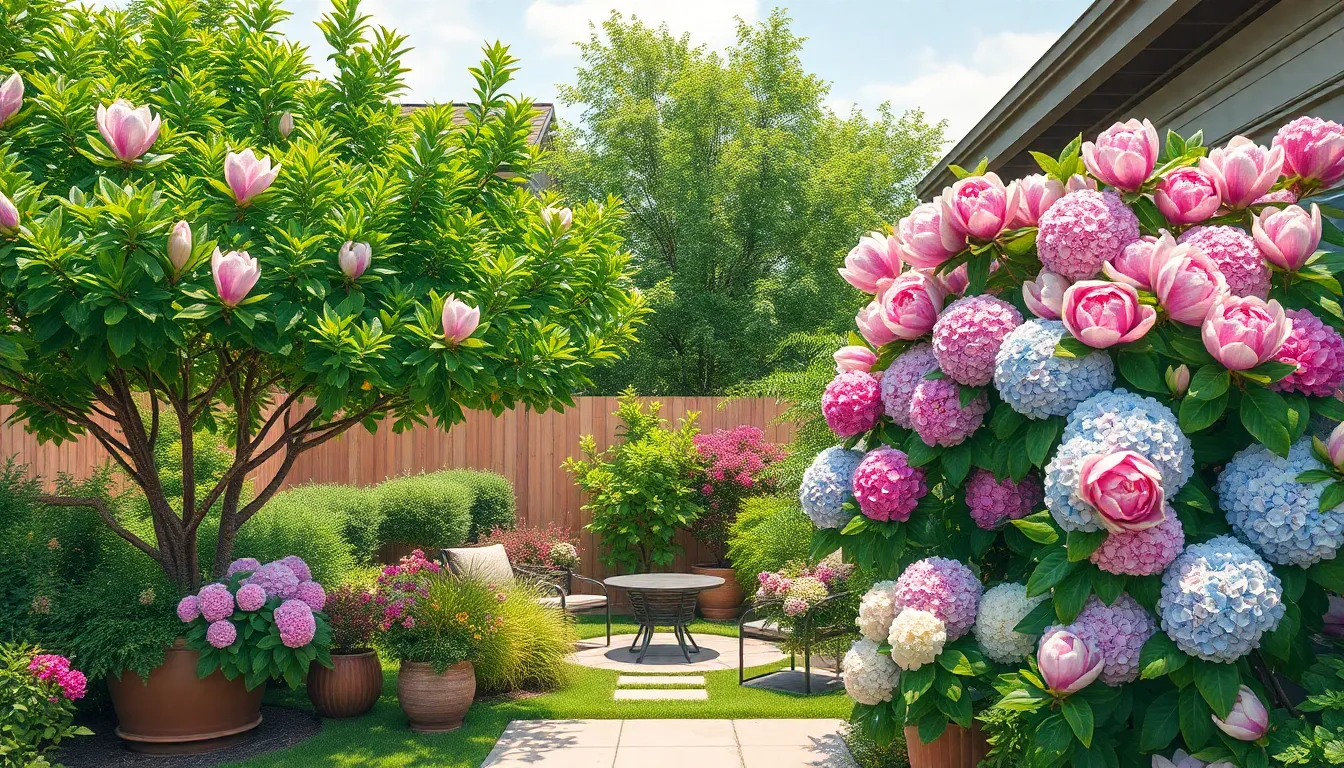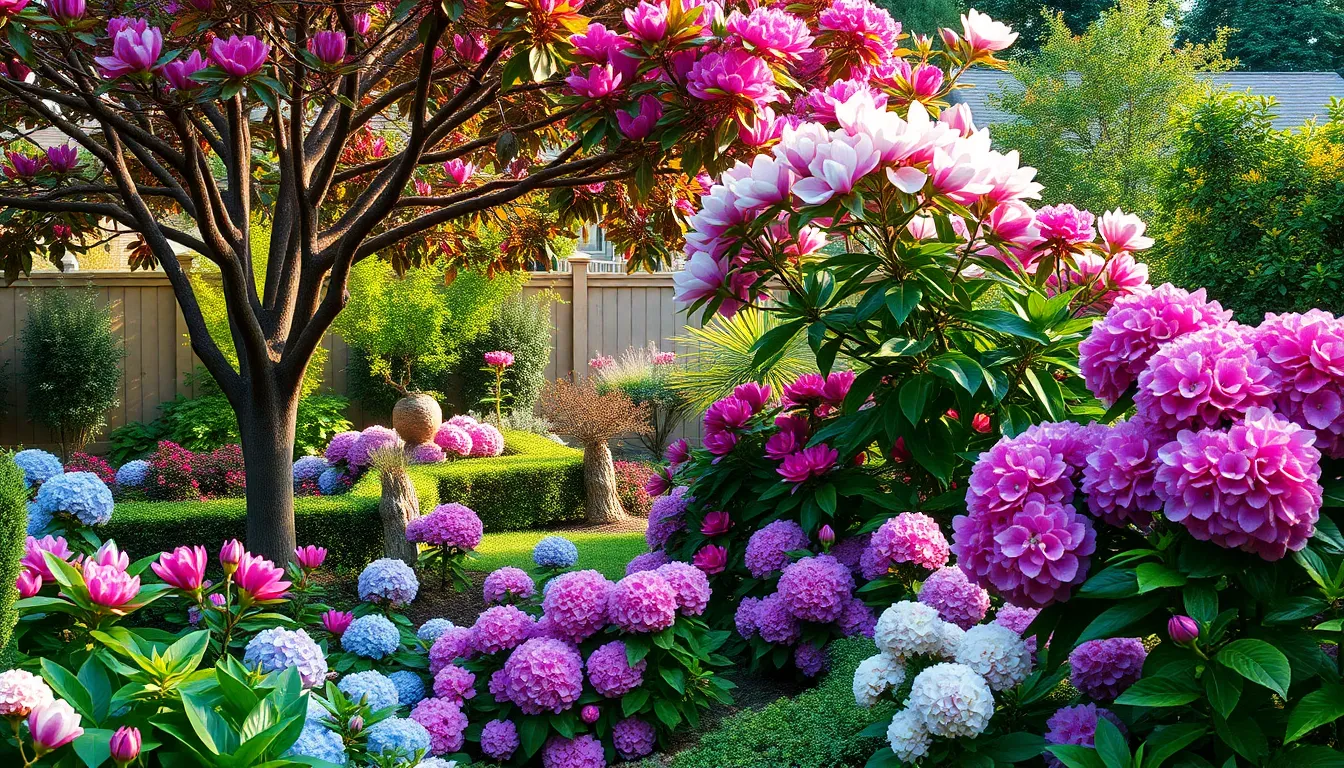When it comes to transforming outdoor spaces, large plants are like the superheroes of the garden world. They swoop in with their towering presence, turning any drab patio or yard into a lush paradise faster than you can say “green thumb.” Imagine your backyard bursting with vibrant foliage that not only looks stunning but also adds a touch of drama. Who wouldn’t want to impress their neighbors with a plant that could double as a small tree?
Large Outdoor Plants
Large outdoor plants come in various forms that all offer unique benefits to outdoor spaces. These categories include trees, shrubs, and vines, each playing a distinctive role in enhancing garden landscapes.
Trees
Trees stand as dominant features in outdoor settings. They provide shade, shelter, and create vertical interest. Popular species like oak, maple, and magnolia often reach impressive heights. Oak trees attract wildlife, including birds and insects, enhancing biodiversity. Maple trees display stunning fall colors, creating beautiful seasonal displays. Magnolias produce large, fragrant flowers that make them focal points in any garden.
Shrubs
Shrubs add structure and depth to gardens. Varieties such as rhododendron, boxwood, and hydrangea grow large enough to serve as natural privacy screens. Rhododendrons bloom with vibrant flowers, bringing color to outdoor spaces. Boxwoods maintain their shape well, making them ideal for formal gardens. Hydrangeas offer impressive blooms that can transform landscapes during summer months.
Vines
Vines offer versatility and beauty by climbing or cascading over structures. Wisteria, clematis, and trumpet vine grow quickly and cover fences, arbors, or trellises effectively. Wisteria produces cascading flower clusters that enchant with their fragrance and appearance. Clemmatis showcases diverse blooming patterns, adding interest year-round. Trumpet vines attract hummingbirds, creating lively garden scenes.
Benefits Of Large Outdoor Plants


Large outdoor plants offer multiple benefits, enriching outdoor spaces in numerous ways.
Aesthetic Appeal
First, large outdoor plants create a striking visual impact, drawing attention from anyone passing by. Dense foliage and vibrant colors enhance the overall design of gardens or patios. Varieties like magnolia trees or hydrangeas add dimension and interest through their impressive sizes and textures. These plants can serve as focal points in landscape design, guiding the eye and creating a harmonious flow. Furthermore, the presence of large plants can transform an ordinary yard into an inviting oasis, providing a lush backdrop for outdoor gatherings and relaxation.
Environmental Impact
Moreover, large outdoor plants contribute positively to the environment. They produce oxygen and improve air quality by filtering pollutants. Tree species, such as oak and maple, support local wildlife by providing shelter and food sources. Additionally, shrubs and vines offer habitats for birds and beneficial insects, promoting biodiversity. Large plants also play a vital role in reducing soil erosion and managing stormwater runoff. Their extensive root systems help stabilize soil, preventing degradation and promoting a healthier ecosystem.
Care And Maintenance
Caring for large outdoor plants ensures their health and longevity. Regular attention to soil, watering, and pruning significantly enhances their growth.
Soil Requirements
Large outdoor plants require well-draining soil to thrive. They prefer a pH level between 6.0 and 7.0, suitable for most species like oak and magnolia. Incorporating organic matter, such as compost, enriches the soil and improves nutrient retention. Mulching around the base helps regulate soil temperature and moisture levels. Testing soil periodically aids in determining nutrient needs, ensuring plants receive adequate fertilization.
Watering Techniques
Watering large plants requires specific methods for optimal growth. Deep watering encourages roots to grow downwards, improving stability. Establishing a routine, such as watering twice a week during dry spells, maintains hydration. Using a drip irrigation system can conserve water while providing consistent moisture. Observing leaf conditions helps identify water stress, indicating the need for adjustment in watering frequency.
Pruning Tips
Pruning large outdoor plants promotes healthy growth and aesthetic appeal. Timing is essential; early spring or fall usually works best for most species. Remove dead or diseased branches to encourage new growth and improve airflow. Shaping the plant helps maintain its desired size and form. Using clean, sharp tools reduces injury to the plant and prevents disease spread.
Choosing The Right Large Outdoor Plants
Selecting suitable large outdoor plants involves understanding several key factors. A few critical components are climate needs and available space.
Climate Considerations
Climate significantly impacts plant selection. Tropical conditions favor species like palms and bamboo, while temperate zones suit maples and oaks. Plants must thrive in the local environment, ensuring they adapt to temperatures and humidity levels.
Choose plants based on hardiness zones, which provide guidance on temperature extremes. Researching frost dates and rainfall patterns aids in making informed choices. Native species often perform better in their natural habitats, offering resilience against pests and diseases. Understanding the specific climate requirements prevents costly mistakes and promotes a thriving outdoor landscape.
Space Availability
Space availability is crucial in choosing large outdoor plants. Analyzing planting areas ensures proper spacing for root systems and growth habits. For instance, trees need ample room to expand, while some shrubs can fit into tighter spaces.
Measure the area to determine how much sunlight it receives daily. Sun-loving plants need locations with direct light, while shade-tolerant varieties work better in less sunny spots. Also, consider the proximity to structures, walkways, or other plants to avoid overcrowding. Optimal space utilization creates a harmonious garden design, enhancing visual appeal and ensuring each plant flourishes.




